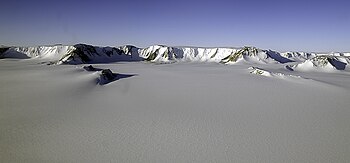Difference between revisions of "Shackleton Range"
(Created page with "The Shackleton Range rising gout of the ice sheet between Slessor and Recovery glaciers {{territory|BAT}} The '''Shackleton...") |
(No difference)
|
Latest revision as of 21:15, 29 March 2021
The Shackleton Range is a mountain range in Coats Land in the British Antarctic Territory. Rising at Holmes Summit to 6,150 feet, it extends in an east–west direction for about 100 miles between the Slessor and Recovery glaciers.
The range was named after Sir Ernest Shackleton, leader of the Imperial Trans-Antarctic Expedition of 1914–16. Where the range extends across the border into Dronning Maud Land, the Norwegian territory, it is known as Shackletonkjeda.
The range includes, from east to west the Otter Highlands, Haskard Highlands, La Grange Nunataks, Fuchs Dome, Herbert Mountains, Shotton Snowfield, Read Mountains and Pioneers Escarpment.
Exploration
The range was seen from the air by the Commonwealth Trans-Antarctic Expedition on 6 February 1956, and surveyed from the ground by the Expedition at its western end in October 1957.
The United States Navy photographed the range from the air in 1967. In 1968–69 and 1969–70, the British Antarctic Survey (based at Halley Station) conducted further ground surveys.
Geography and geology
The Haskard Group and Turnpike Bluff Group rest unconformably on the Archean-Middle Proterozoic Shackleton Range Metamorphic Complex. The Ordovician-Early Devonian Blaiklock Glacier Group (475 Ma) also unconformably overlies the Shackleton Range Metamorphic Complex. This group is composed of sandstones and conglomerates, and is unconformably overlain by the Beacon Supergroup.[1]
Geographical features include:
Location
- Location map: 80°30’0"S, 25°0’0"W
References
- ↑ Laird, M.G. (1991). Thomson, M.R.A.; Crame, J.A.; Thomson, J.W.. eds. Lower-mid-Palaeozoic sedimentation and tectonic patterns on the palaeo-Pacific margin of Antarctica, in Geological Evolution of Antarctica. Cambridge: Cambridge University Press. pp. 178–179. ISBN 9780521372664.
- Gazetteer and Map of The British Antarctic Territory: Shackleton Range
